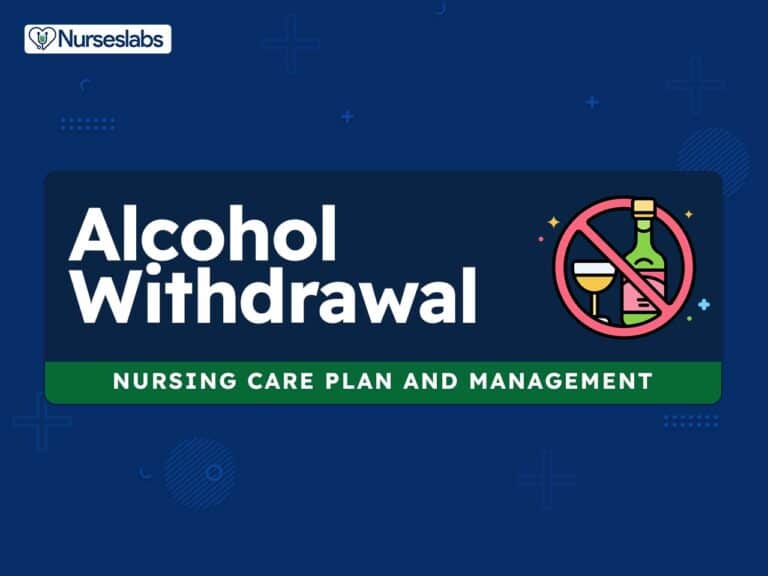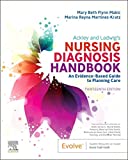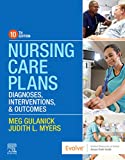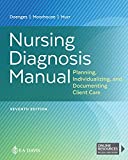

Alcohol withdrawal syndrome (AWS) is a common clinical condition that occurs in individuals with alcohol use disorder who abruptly stop or reduce their alcohol intake. It is characterized by a range of symptoms that can vary from mild to severe and potentially life-threatening. Nursing care plans for alcohol withdrawal are an essential part of managing patients with AWS. This article aims to provide an overview of nursing care plans for alcohol withdrawal nursing assessment, nursing diagnosis, including their nursing interventions, and nursing management.
Alcohol, a central nervous system depressant, is used socially in our society for many reasons: to enhance the flavor of food, to encourage relaxation and conviviality, for celebrations, and as a sacred ritual in some religious ceremonies. Therapeutically, it is the major ingredient in many OTC/prescription medications. It can be harmless, enjoyable, and sometimes beneficial when used responsibly and in moderation.
It is rapidly absorbed from the stomach and small intestine into the bloodstream. On the other hand, alcohol withdrawal refers to symptoms that may occur when a person who has been drinking too much alcohol every day suddenly stops drinking alcohol.
Alcohol withdrawal symptoms usually occur within 8 hours after the last drink but can occur days later. Symptoms usually peak in 24 – 72 hours but may persist for weeks. Common symptoms include anxiety or nervousness, depression, fatigue, irritability, jumpiness or shakiness, mood swings, nightmares and not thinking clearly.
Nursing care plans for alcohol withdrawal are designed to support patients with AWS and ensure their safety and comfort during the withdrawal process. Nursing care planning for patients who are undergoing alcohol withdrawal includes: maintaining physiological stability during the acute withdrawal phase, promoting safety, providing appropriate referral and follow-up, and involvement of SO in the process.
The following are the nursing priorities for patients with alcohol withdrawal syndrome (AWS):
Assess for the following subjective and objective data:
Following a thorough assessment, a nursing diagnosis is formulated to specifically address the challenges associated with alcohol withdrawal syndrome (AWS) based on the nurse’s clinical judgment and understanding of the patient’s unique health condition. While nursing diagnoses serve as a framework for organizing care, their usefulness may vary in different clinical situations. In real-life clinical settings, it is important to note that the use of specific nursing diagnostic labels may not be as prominent or commonly utilized as other components of the care plan. It is ultimately the nurse’s clinical expertise and judgment that shape the care plan to meet the unique needs of each patient, prioritizing their health concerns and priorities.
Goals and expected outcomes may include:
Therapeutic interventions and nursing actions for patients with alcohol withdrawal syndrome (AWS) may include:
Patients with alcohol withdrawal may experience sensory perceptual changes due to a combination of factors, including chronic alcohol consumption, sleep deprivation, and psychological stress. These factors can contribute to alterations in the patient’s perception of their surroundings, such as visual or auditory hallucinations, as well as difficulties in clear thinking and information processing. Additionally, patients with alcohol withdrawal are susceptible to decreased cardiac output, which may occur as a direct consequence of alcohol’s impact on the heart muscle, resulting in damage and impaired function. It can also cause changes in systemic vascular resistance, affecting blood flow and cardiac performance. In severe cases, reduced cardiac output can lead to complications like hypotension, shock, and organ failure. Moreover, patients with alcohol withdrawal are prone to impaired respiratory function caused by tracheobronchial obstruction, which can arise from incidents involving aspiration or choking. Furthermore, alcohol toxicity depresses the central nervous system and impairs respiratory function, which can contribute to various respiratory complications, including hypoxemia and respiratory failure.
Assess the level of consciousness; ability to speak, and respond to stimuli and commands.
Speech may be garbled, confused, or slurred. Response to commands may reveal an inability to concentrate, impaired judgment, or muscle coordination deficits.
Observe behavioral responses such as hyperactivity, disorientation, confusion, sleeplessness, and irritability.
Hyperactivity related to CNS disturbances may escalate rapidly. Sleeplessness is common due to the loss of the sedative effect gained from alcohol usually consumed before bedtime. Sleep deprivation may aggravate disorientation and confusion. Progression of symptoms may indicate impending hallucinations (stage II) or DTs (stage III).
Note the onset of hallucinations. Document as auditory, visual, and tactile.
Auditory hallucinations are reported to be more frightening and threatening to the patient. Visual hallucinations occur more at night and often include insects, animals, or the faces of friends and enemies. Patients are frequently observed “picking the air.” Yelling may occur if the patient is calling for help from a perceived threat (usually seen in stage III AWS).
Monitor the patient for signs of depression.
To avoid harming himself and attempts suicide.
Monitor laboratory studies: electrolytes, magnesium levels, liver function studies, ammonia, BUN, glucose, and ABGs.
Changes in organ function may precipitate or potentiate sensory-perceptual deficits. Electrolyte imbalance is common. Liver function is often impaired in the chronic alcoholic, and ammonia intoxication can occur if the liver is unable to convert ammonia to urea. Ketoacidosis is sometimes present without glycosuria; however, hyperglycemia or hypoglycemia may occur, suggesting pancreatitis or impaired gluconeogenesis in the liver. Hypoxemia and hypercarbia are common manifestations in chronic alcoholics who are also heavy smokers.
Provide a calm environment, minimizing noise and shadows.
To reduce the incidence of delusions and hallucinations.
Avoid restraining the patient unless necessary.
To protect patients and others.
Provide a quiet environment. Speak in a calm, quiet voice. Regulate lighting as indicated. Turn off the radio and TV during sleep.
Reduces external stimuli during the hyperactive stage. Patients may become more delirious when their surroundings cannot be seen, but some respond better to quiet, darkened rooms.
Provide care by the same staff whenever possible.
Promotes recognition of caregivers and a sense of consistency, which may reduce fear.
Encourage SO to stay with the patient whenever possible.
May have a calming effect, and may provide a reorienting influence.
Reorient frequently to person, place, time, and surrounding environment as indicated.
May reduce confusion, and prevent and limit misinterpretation of external stimuli.
Avoid bedside discussion about the patient or topics unrelated to the patient that does not include the patient.
Patients may hear and misinterpret conversation, which can aggravate hallucinations.
Provide environmental safety (place bed in a low position, leave doors in a fully open or closed position, observe frequently, place call light or bell within reach, remove articles that can harm the patient).
Patients may have a distorted sense of reality or be fearful or suicidal, requiring protection from self.
Provide seclusion, and restraints as necessary.
Patients with excessive psychomotor activity, severe hallucinations, violent behavior, and suicidal gestures may respond better to seclusion. Restraints are usually ineffective and add to the patient’s agitation, but occasionally may be required to prevent self-harm.
Orient the patient to reality.
Patients may experience hallucinations and may try to harm themselves and others.
Administer medications as indicated: Antianxiety agents as indicated
Reduces hyperactivity, promoting relaxation and sleep. Drugs that have little effect on dreaming may be desired to allow dream recovery (REM rebound) to occur, which has previously been suppressed by alcohol use.
Monitor vital signs frequently during acute withdrawal.
Hypertension frequently occurs in the acute withdrawal phase. Extreme hyperexcitability, accompanied by catecholamine release and increased peripheral vascular resistance, raises BP and heart rate; however, BP may become labile and progress to hypotension. Note: The patient may have underlying cardiovascular disease, which is compounded by alcohol withdrawal.
Monitor cardiac rate and rhythm. Document irregularities and dysrhythmias.
Long-term alcohol abuse may result in cardiomyopathy or HF. Tachycardia is common because of the sympathetic response to increased circulating catecholamines. Irregularities and dysrhythmias may develop with electrolyte shifts and imbalance. All of these may have an adverse effect on cardiac function and output.
Monitor body temperature.
Elevation may occur because of sympathetic stimulation, dehydration, and infections, causing vasodilation and compromising venous return and cardiac output.
Monitor I&O. Note 24-hr fluid balance.
Preexisting dehydration, vomiting, fever, and diaphoresis may result in decreased circulating volume that can compromise cardiovascular function. Note: Hydration is difficult to assess in the alcoholic patient because the usual indicators are not reliable, and overhydration is a risk in the presence of compromised cardiac function.
Monitor laboratory studies: serum electrolyte levels.
Electrolyte imbalance: potassium, and magnesium, potentiate the risk of cardiac dysrhythmias and CNS excitability.
Be prepared and assist in cardiopulmonary resuscitation.
Causes of death during acute withdrawal stages include cardiac dysrhythmias, respiratory depression and arrest, oversedation, excessive psychomotor activity, severe dehydration or overhydration, and massive infections. Mortality for unrecognized and untreated delirium tremens (DTs) may be as high as 25%.
Administer fluids and electrolytes, as indicated.
Severe alcohol withdrawal causes the patient to be susceptible to fluid losses (associated with fever, diaphoresis, and vomiting) and electrolyte imbalances, especially potassium, magnesium, and glucose.
Administer medications as indicated: Clonidine (Catapres), atenolol (Tenormin); Potassium.
Although the use of benzodiazepines is often sufficient to control hypertension during initial withdrawal from alcohol, some patients may require more specific therapy. Note: Atenolol and other b-adrenergic blockers may speed up the withdrawal process and eliminate tremors, as well as lower the heart rate, blood pressure, and body temperature.
Corrects deficits that can result in life-threatening dysrhythmias.
Monitor respiratory rate and depth and pattern as indicated. Note periods of apnea, and Cheyne-Stokes respirations.
Frequent assessment is important because toxicity levels may change rapidly. Hyperventilation is common during the acute withdrawal phase. Kussmaul’s respirations are sometimes present because of an acidotic state associated with vomiting and malnutrition. However, marked respiratory depression can occur because of the CNS depressant effects of alcohol if acute intoxication is present. This may be compounded by drugs used to control alcohol withdrawal symptoms (AWS).
Auscultate breath sounds. Note the presence of adventitious sounds: rhonchi, wheezes.
The patient is at risk for atelectasis related to hypoventilation and pneumonia. Right lower lobe pneumonia is common in alcohol-debilitated patients and is often due to chronic aspiration. Chronic lung diseases are also common: emphysema and bronchitis.
Review serial chest x-rays, ABGs, and pulse oximetry as available and indicated
Monitors the presence of secondary complications such as atelectasis and pneumonia; evaluates the effectiveness of respiratory effort, identifies therapy needs.
Elevate the head of the bed.
Decreases potential for aspiration; lowers diaphragm, enhancing lung inflation.
Encourage cough and deep-breathing exercises and frequent position changes.
Facilitates lung expansion and mobilization of secretions to reduce the risk of atelectasis and pneumonia.
Have suction equipment, and airway adjuncts available.
The sedative effects of alcohol and drugs potentiate the risk of aspiration, relaxation of oropharyngeal muscles, and respiratory depression, requiring intervention to prevent respiratory arrest.
Administer supplemental oxygen if necessary.
Hypoxia may occur with CNS and respiratory depression.
Patients with alcohol withdrawal are at risk for injury due to a variety of factors, including sudden cessation of alcohol, which can lead to severe physiological symptoms, such as seizures. Reduced hand and eye coordination, balancing difficulties, and confusion can also increase the risk of falls and other accidents, which can lead to serious injury. Additionally, some patients may engage in risky or impulsive behaviors as a result of their altered state of mind, further increasing the risk of injury.
Identify the stage of AWS (alcohol withdrawal syndrome); i.e., stage I is associated with signs and symptoms of hyperactivity (tremors, sleeplessness, nausea and vomiting, diaphoresis, tachycardia, hypertension). Stage II is manifested by increased hyperactivity plus hallucinations and seizure activity. Stage III symptoms include DTs and extreme autonomic hyperactivity with profound confusion, anxiety, insomnia, and fever.
Prompt recognition and intervention may halt the progression of symptoms and enhance recovery or improve prognosis. In addition, the recurrence or progression of symptoms indicates the need for changes in drug therapy and more intense treatment to prevent death.
Monitor and document seizure activity. Maintain patent airway. Provide environmental safety (padded side rails, bed in low position).
Grand mal seizures are most common and may be related to decreased magnesium levels, hypoglycemia, elevated blood alcohol, or a history of head trauma and preexisting seizure disorder. Note: In absence of history and other pathology causing seizures, they usually stop spontaneously, requiring only symptomatic treatment. Note: Antiepileptic drugs are not indicated for alcohol withdrawal seizures.
Check deep-tendon reflexes. Assess gait, if possible.
Reflexes may be depressed, absent, or hyperactive. Peripheral neuropathies are common, especially in malnourished patients. Ataxia (gait disturbance) is associated with Wernicke’s syndrome (thiamine deficiency) and cerebellar degeneration.
Assist with ambulation and self-care activities as needed.
Prevents falls with resultant injury.
Provide for environmental safety when indicated.
May be required when equilibrium, hand, and eye coordination problems exist.
Administer medications as indicated.
See Pharmacologic Management
Patients with alcohol withdrawal are at risk for anxiety and fear related to the cessation of alcohol intake and physiological withdrawal symptoms. Hospitalization and the threat to self-concept can further exacerbate these feelings, as patients may feel a loss of control over their own lives and worry about the impact of their condition on their relationships and daily activities.
Determine the cause of anxiety, involving the patient in the process. Explain that alcohol withdrawal increases anxiety and uneasiness. Reassess the level of anxiety on an ongoing basis.
A person in the acute phase of withdrawal may be unable to identify and accept what is happening. Anxiety may be physiologically or environmentally caused. Continued alcohol toxicity will be manifested by increased anxiety and agitation as the effects of the medication wear off.
Monitor the patient for signs of depression.
To prevent suicidal attempts.
Develop a trusting relationship through frequent contact being honest and nonjudgmental. Project an accepting attitude about alcoholism.
Provides patient with a sense of humanness, helping to decrease paranoia and distrust. Patients will be able to detect the biased or condescending attitudes of caregivers.
Maintain a calm environment, minimizing noise.
Reduces stress.
Inform the patient about what you plan to do and why. Include patients in the planning process and provide choices when possible.
Enhances a sense of trust, and explanation may increase cooperation and reduce anxiety. Provides a sense of control over self in circumstances where the loss of control is a significant factor. Note: Feelings of self-worth are intensified when one is treated as a worthwhile person.
Reorient frequently.
The patient may experience periods of confusion, resulting in increased anxiety.
Orient the patient to reality.
He may also experience hallucinations and may try to harm himself and others.
Administer medications as indicated.
See Pharmacologic Management
Arrange “Intervention” (confrontation) in a controlled setting.
Process wherein SO and family members, supported by staff, provide information about how the patient’s drinking and behavior have affected each one of them, helps the patient acknowledge that drinking is a problem and has resulted in the current situational crisis.
Provide consultation for referral to detoxification and crisis center for ongoing treatment programs as soon as medically stable (oriented to reality).
The patient is more likely to contract treatment while still hurting and experiencing fear and anxiety from the last drinking episode. Motivation decreases as well-being increases and the person again feel able to control the problem. Direct contact with available treatment resources provides a realistic picture of help. Decreases time for patients to “think about it,” change minds or restructure and strengthen denial systems.
These nursing interventions aim to empower patients with knowledge and skills to manage their alcohol withdrawal syndrome effectively and promote successful recovery.
Provide thorough education to patients with AWS regarding the physical and psychological effects of alcohol withdrawal, including symptoms, risks, and potential complications.
Providing education about the physical and psychological effects of alcohol withdrawal helps patients understand what to expect during the process, reducing anxiety and increasing their motivation to stay committed to treatment.
Teach patients healthy coping mechanisms and stress management techniques, such as deep breathing exercises, mindfulness techniques, and engaging in activities that promote relaxation.
Teaching patients healthy coping strategies and stress management techniques equips them with effective tools to manage triggers and cravings, reducing the likelihood of relapse and promoting long-term recovery.
Educate patients about available support systems, such as Alcoholics Anonymous (AA) or other support groups, counseling services, and community resources, and encourage their participation to enhance their recovery journey.
Educating patients about available support systems and resources, such as support groups and counseling services, helps them establish a strong support network, providing encouragement, guidance, and a sense of belonging during their recovery journey.
Explain the importance of medication adherence in managing AWS and provide clear instructions on the prescribed medications, their purpose, potential side effects, and proper dosage. Emphasize the significance of following the prescribed medication regimen and attending scheduled medical appointments for monitoring and adjustment of treatment if necessary.
Providing clear instructions on medication use and emphasizing the importance of adherence ensures that patients receive the full benefits of prescribed medications, reducing withdrawal symptoms and minimizing the risk of complications. Regular monitoring allows for adjustments to the treatment plan, ensuring its effectiveness.
Provide education on the importance of a balanced diet, adequate hydration, and regular physical activity to support overall health and recovery. Discuss the negative effects of alcohol on nutrition and encourage healthy habits, such as consuming nutritious meals, avoiding alcohol, and staying hydrated.
Educating patients about the impact of alcohol on nutrition and overall health helps them recognize the importance of a balanced diet, hydration, and regular physical activity in supporting their recovery. This knowledge empowers patients to make healthier lifestyle choices and promotes overall well-being.
Benzodiazepines: chlordiazepoxide (Librium), diazepam (Valium)
Antianxiety agents are given during acute withdrawal to help the patient relax, be less hyperactive, and feel more in control.
Barbiturates: phenobarbital, or possibly secobarbital (Seconal), pentobarbital (Nembutal)
These drugs suppress alcohol withdrawal but need to be used with caution because they are respiratory depressants and REM sleep cycle inhibitors.
Benzodiazepines (BZDs): chlordiazepoxide (Librium), diazepam (Valium), clonazepam (Klonopin), oxazepam (Serax), clorazepate (Tranxene)
BZDs are commonly used to control neuronal hyperactivity because of their minimal respiratory and cardiac depression and anticonvulsant properties. Studies have also shown that these drugs can prevent progression to more severe states of withdrawal. IV and PO administration is the preferred route because IM absorption is unpredictable. Muscle-relaxant qualities are particularly helpful to patients in controlling “the shakes,” trembling, and ataxic quality of movements. Patients may initially require large doses to achieve the desired effect, and then drugs may be tapered and discontinued, usually within 96 hr. Note: These agents are used cautiously in patients with known hepatic disease because they are metabolized by the liver, although Serax has a shorter half-life.
Haloperidol (Haldol)
May be used in conjunction with BZDs for patients experiencing hallucinations.
Thiamine
Thiamine deficiency (common in alcohol abuse) may lead to neuritis, Wernecke’s syndrome, and Korsakoff’s psychosis.
Magnesium sulfate
Reduces tremors and seizure activity by decreasing neuromuscular excitability.
Recommended nursing diagnosis and nursing care plan books and resources.
Disclosure: Included below are affiliate links from Amazon at no additional cost from you. We may earn a small commission from your purchase. For more information, check out our privacy policy.
Ackley and Ladwig’s Nursing Diagnosis Handbook: An Evidence-Based Guide to Planning Care
We love this book because of its evidence-based approach to nursing interventions. This care plan handbook uses an easy, three-step system to guide you through client assessment, nursing diagnosis, and care planning. Includes step-by-step instructions showing how to implement care and evaluate outcomes, and help you build skills in diagnostic reasoning and critical thinking.

Nursing Care Plans – Nursing Diagnosis & Intervention (10th Edition)
Includes over two hundred care plans that reflect the most recent evidence-based guidelines. New to this edition are ICNP diagnoses, care plans on LGBTQ health issues, and on electrolytes and acid-base balance.

Nurse’s Pocket Guide: Diagnoses, Prioritized Interventions, and Rationales
Quick-reference tool includes all you need to identify the correct diagnoses for efficient patient care planning. The sixteenth edition includes the most recent nursing diagnoses and interventions and an alphabetized listing of nursing diagnoses covering more than 400 disorders.

Nursing Diagnosis Manual: Planning, Individualizing, and Documenting Client Care
Identify interventions to plan, individualize, and document care for more than 800 diseases and disorders. Only in the Nursing Diagnosis Manual will you find for each diagnosis subjectively and objectively – sample clinical applications, prioritized action/interventions with rationales – a documentation section, and much more!

All-in-One Nursing Care Planning Resource – E-Book: Medical-Surgical, Pediatric, Maternity, and Psychiatric-Mental Health
Includes over 100 care plans for medical-surgical, maternity/OB, pediatrics, and psychiatric and mental health. Interprofessional “patient problems” focus familiarizes you with how to speak to patients.

Other recommended site resources for this nursing care plan:
Other care plans for mental health and psychiatric nursing:
Matt Vera, a registered nurse since 2009, leverages his experiences as a former student struggling with complex nursing topics to help aspiring nurses as a full-time writer and editor for Nurseslabs, simplifying the learning process, breaking down complicated subjects, and finding innovative ways to assist students in reaching their full potential as future healthcare providers.